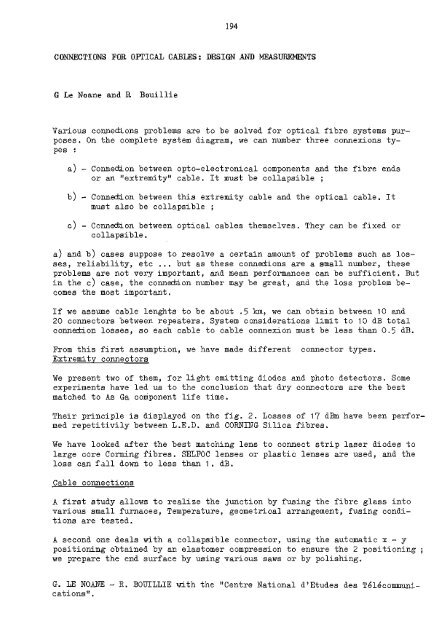ECOC 1975 - ECOC 2013
ECOC 1975 - ECOC 2013
ECOC 1975 - ECOC 2013
Create successful ePaper yourself
Turn your PDF publications into a flip-book with our unique Google optimized e-Paper software.
194<br />
CONNECTIONS FOR OPrICAL CABLES: DESIGN AND MEASUREMENTS<br />
G Le Noane and R Bouillie<br />
Various connedions problems are to be solved for optical fibre systems purposes.<br />
On the complete system diagram, we can number three connexions types<br />
:<br />
a) - Connection between opto-electronical components and the fibre ends<br />
or an "extremity" cable. It must be collapsible;<br />
b) - Conne±ion between this extremity cable and the optical cable. It<br />
must also be collapsible ;<br />
c) - Connedion between optical cables themselves. They can be fixed or<br />
collapsible.<br />
a) and b) cases suppose to resolve a certain amount of problems such as losses,<br />
reliability, etc •.• but as these conne±ions are a small number, these<br />
problems are not very important, and mean performances can be sufficient. But<br />
in the c) case, the connation number may be great, and the loss problem becomes<br />
the most important.<br />
If we assume cable lenghts to be about .5 km, we can obtain between 10 and<br />
20 connectors between repeaters. System considerations limit to 10 dB total<br />
conne±ion losses, so each cable to cable connexion must be less than 0.5 dB.<br />
From this first assumption, we have made different connector types.<br />
Extremity connectors<br />
We present two of them, for light emitting diodes and photo detectors. Some<br />
experiments have led us to the conclusion that dry connectors are the best<br />
matched to As Ga component life time.<br />
Their principle is displayed on the fig. 2. Losses of 17 dBm have been performed<br />
repetitivily between L.E.D. and CORNING Silica fibres.<br />
We have looked after the best matching lens to connect strip laser diodes to<br />
large core Corning fibres. SELFOC lenses or plastic lenses are used, and the<br />
loss can fall down to less than 1. dB.<br />
Cable connections<br />
A first study allows to realize the junction by fusing the fibre glass into<br />
various small furnaces, Temperature, geometrical arrangement, fusing conditions<br />
are tested.<br />
A second one deals with a collapsible connector, using the automatic x - y<br />
positioning obtained by an elastomer compression to ensure the 2 positioning<br />
we prepare the end surface by using various saws or by polishing.<br />
G. LE NOANE - R. BOUILLIE with the "Centre National d'Etudes des Telecommunications".


